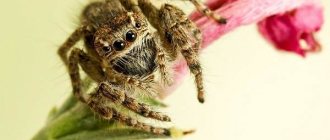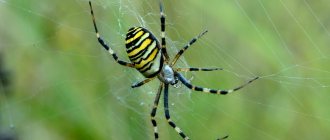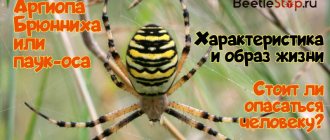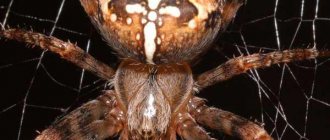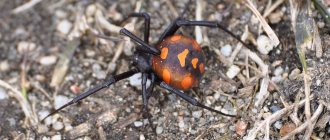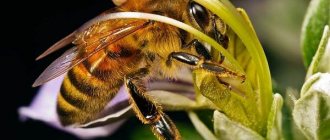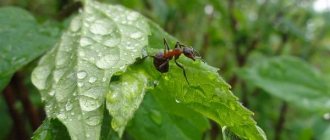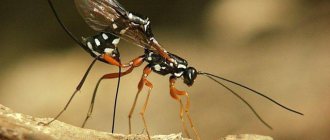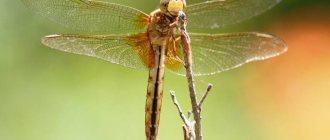There are several names for this most poisonous karakurt spider that lives on our Planet. This spider is called a “black worm”, and translated from Kalmyk spider it is called a “black widow”. The last name is the most suitable for this type of spider, since females after mating can easily eat their sexual partners. The Black Widow is no less dangerous to humans. Naturally, this applies more to sexually mature females. These spiders move relatively quickly.
Experts have proven that karakurt venom is one and a half to two dozen times more toxic than the toxicity of the venom of the most poisonous snake living in the wild. Males are not capable of causing harm to humans, since they are characterized by significantly smaller sizes, and they are not able to bite through human skin. For humans, a “black widow” is also a mystical living creature due to the fact that there are 13 red spots on the spider’s body.
Spreading
Widely distributed in Southern Europe, Western Asia and North Africa - from Portugal and Spain to Central Asia. For example, in Bulgaria, karakurt inhabits the southern parts of the country - the Strandzha, Sakar and other elevated areas; during the summer months it moves north. In Russia it is found from the European part to southern Siberia.
Female hiding in the corner of a trapping net, Moncodonja, Croatia
It lives on plains - in fields, meadows, arable lands, steppe regions and especially on grassy uncultivated lands, open dry areas. It can be found in barns, stables and even in human habitations. Found on dunes, sandy and rocky shores.
Rocky coastal landscape near the town of Calvi on the French island of Corsica, one of the habitats of the karakurt
Typically found frequently in suitable habitats. However, the prevalence fluctuates greatly and varies from year to year. In Istria (a peninsula in the Adriatic Sea, in the northern part of Croatia), for example, in some years the species was almost not found, in others, on the contrary, the number of spiders there was quite high.
Due to its high population density and prevalence, the status of the species is not of concern.
Area
Karakurts are steppe spiders that prefer dry areas with warm winters. The territories where karakurts live occupy the entire dry belt of the Eurasian continent: from Spain to the steppe part of China.
In Russia, the northern limit of distribution of karakurts is indicated as 50° N. w. But in hot summers these spiders were also found further north. They even came across on the shores of Lake Onega.
Interesting!
With a high degree of probability, arthropods did not penetrate to the north on their own, but with the help of humans. They cannot take root there and die in winter.
In Central Asia, 3 types of karakurts live on the same territory:
- thirteen-spotted (Latrodectus tredecimguttatus);
- Dahl's karakurt (Latrodectus dahli);
- white (Latrodectus pallidus).
Types of karakurt spider
Thirteen-spotted is divided into 2 subspecies: Asian and European. The second name of the latter is European widow.
Description
The body length of females is from 7 to 15 mm, males - from 4 to 7 mm. Black in color, males and young females have thirteen red spots on the opisthosoma (abdomen), giving the species the name tredecimgutattus (Latin for “thirteen spots”); sometimes these spots are absent, and the spider can be completely black, and the spots can also merge. On the ventral (ventral) side there is a red hourglass-shaped pattern typical of true widows (Latrodectus), which, however, can also be reduced in some individuals to two transverse stripes. The body is covered with velvety hairs. The hairs are forked.
As with other species of true widows, the male European black widow is significantly smaller than the female. Sexual dimorphism (difference between sexes) is also expressed in differences in shape and color.
Female
Females
The main color of the female is black. Prosoma is from 3 to 5.2 mm long, black in color, appears shiny, slightly longer than wide. The legs are black, longer and stronger than those of the male.
Opisthosoma spherical. The spots are edged with white, especially in young females. The epigyn (female genital organ) consists of two connected sperm receptacles (sperm sacs).
Female
Males
The male is much smaller than the female and has a less strong build, and has a more contrasting color. The main color is also black, but with a noticeable brownish tint. The spots on the opisthosoma of males are bordered with white, like those of young females.
Male
Characteristic
Karakurt females differ from males in both appearance and size.
If the males are frail, black and no more than 7 mm in length, then the females are simply heroes: about 1 cm in length (there are also individuals up to 2 cm in length) with long three-centimeter legs - the models would be envious.
And they are rare beauties - the back is decorated with red polka dots.
Interesting! Eurasian karakurt spiders in adulthood no longer have spots, but American and Australian spiders are always spotted.
Spiders can be called aristocrats, because they have blue blood.
This is due to the fact that they have hemocyanin in their blood, not hemoglobin, that is, it is not iron, but copper, that is responsible for the color of the blood.
Spiders can be called aristocrats, because they have blue blood. This is due to the fact that they have hemocyanin in their blood, not hemoglobin, that is, copper, not iron, is responsible for the color of the blood
Global warming has caused spiders to refuse to sleep in winter.
In autumn, when the first frosts appear, the soil becomes cold and spiders die en masse.
But at the same time they manage to leave offspring.
Spiderlings grow in cocoons - they are warm and comfortable there, and only come out of their houses in the summer.
That's when - in July and August - they can bite and inject poison under the skin.
Interesting! It would seem that karakurts are not afraid of anyone. But that's not true. Flocks of sheep trample their nests in the steppes and clearings, sphex wasps inject poison into spiders, paralyzing them, insect riders (these are flies with wings - a cross between mosquitoes, flies and wasps) lay their eggs in cocoons with spiderlings and hedgehogs - karakurt It just won’t reach the hedgehog’s body through its prickly coat.
Karakurt is a predator, and its digestive system is extraintestinal. When attacking a victim, the spider pierces it with its upper jaws (chelicerae) and injects poison. Moreover, he gives several such injections so that the “food” cooks faster. When everything is digested, the karakurt sucks out the contents
Similar species
Confusion sometimes arises with similar species of black widows (Latrodectus), as well as with species from the genus Steatoda, which also belongs to the family of web spiders (Theridiidae), such as the false karakurt, or Paykull's steatoda (S. paykulliana). It is similar to the karakurt in the shape of the opisthosoma and also has noticeable markings, but usually has only one red or yellow transverse stripe on the lower part of the abdomen.
In addition, the karakurt is usually slightly larger than the false karakurt and has a different eye arrangement. In addition, in all steatodes, including false karakurt, unlike black widows, the chelicerae are serrated.
The false karakurt is also found in the Mediterranean and prefers habitats similar to those of the karakurt.
Female false karakurt (Steatoda paykulliana)
Lifestyle and habitat
The spider is more often found on sun-warmed slopes of ravines, ditches, and along the banks of irrigation ditches. Prefers wastelands, virgin lands, arable lands, dry steppes, semi-deserts. On the overgrown banks of salt lakes and rivers, there can be especially many poisonous spiders.
For a full life cycle, karakurt needs a long summer, warm autumn, and mild winter. Arthropods avoid flat terrain and choose rocky terrain with depressions in the soil for successful settlement.
Spiders are attracted to abandoned burrows, earthen crevices, and depressions in the soil. The black karakurt can settle in a utility room, climb into a lonely building, or enter a house. Due to climatic conditions, the southern regions of Russia are ideal habitats for arthropods.
Dal's Karakurt has a solid black color
There are especially many karakurts in the Astrakhan region, Kalmykia, Krasnodar and Stavropol territories. If the hot summer is delayed, then the spiders move north, to the Voronezh and Tambov regions. Karakurts in the Moscow region are an extremely rare phenomenon. But possible. With the first cold weather, they will all die, and the left cocoons with their offspring will freeze out over the long winter.
The activity of poisonous spiders occurs day and night. By weaving webs, they set up nets to catch prey. It is easy to distinguish the work of karakurts by the random accumulation of threads, in contrast to orb-weaving spiders, which have regular weaving patterns.
The horizontal plane of the web is another factor that identifies karakurts. This way, they are more successful in keeping watch from above for the main victims - locusts and grasshoppers moving along the ground. Other shadow creatures weave mainly vertical traps.
Tourists who notice a thick horizontal web in rocky crevices should not pitch a tent nearby, as there is a high probability of accidentally meeting with a poisonous hunter. Spiders, as a rule, do not attack first. A bite is possible in a situation where a person did not notice the karakurt, stepped on a nest, or touched a cobweb.
The lair of the karakurt is easy to spot by the horizontally woven web
Tents should be ventilated through a mesh and protected with a canopy. Only a male karakurt , but he is not capable of causing much harm. When hiking, you must wear closed shoes and clothing that protect your body from sudden attacks by living creatures.
You cannot leave things or shoes outside the tent during an overnight stay. Spiders take them for shelter. A bite is inevitable if the karakurt is inside the boot that a tourist puts on in the morning without shaking it out. Poisonous karakurt is very prolific, periodically the population size experiences a peak of sharp increase.
Since June, they migrate in search of shelter from the heat and suitable places for mating. In nature, spiders also have enemies who can even feed on karakurts without fear of poison. Not sensitive to toxins, pigs, sheep, and goats trample entire hectares of steppes along with the nests where the karakurt lives .
Only after such treatment do shepherds release horses and camels that are sensitive to spider venom to graze. Burrowing wasps destroy spiders in their own way, by injecting a paralyzing substance. Iridescent beetles find karakurt cocoons to lay their larvae in them. The offspring of the beetles deal with the defenseless spider nymphs. Karakurts are a delicacy for hedgehogs. The needles protect the animal from the threat of a bite; the spider cannot harm its prickly enemy.
Lifestyle
It stays close to the ground and, like many web spiders, constructs a trapping network typical of the family for the purpose of catching prey, consisting of several trapping threads stretching to the ground. At the top there is a key-shaped shelter that serves as a night shelter. The net is usually placed near the ground, in the grass or under overhanging rocks.
Female in a trapping net, Rabac (Istrian peninsula), Croatia
Spectrum of production
Karakurt has a wide range of prey, as the nature of trap net construction means that food is taken passively. The range of prey also depends on the age stage of the spider. Typically, food consists of various arthropods, especially large insects.
Female with a captured male longhorned beetle Psilotarsus brachypterus
Thanks to its effective fishing technique, the karakurt can catch very large or difficult prey, such as large locusts. Other spiders also serve as prey, including males of other species that wander at night in search of females, ending up in the hunting nets of karakurts. There are also reports of small vertebrates, mainly lizards, being caught.
Female, on the right are the remains of prey - another spider
Life cycle
The life cycle of karakurt is divided into several phases and also depends on the season.
Phenology
The active period of adult females is from May to November. In adult males this period is shorter and they are found from May to September.
Reproduction
A sexually mature male looks for a female that has not yet matured and penetrates her network, which he usually never leaves. Once the female moults for the last time and becomes an adult, he ties her up in a web and mates with her. The female quickly frees herself from the threads and usually devours the male, hence the name “black widow”, coupled with its appearance.
Some time after mating, the female weaves up to five cocoons, 14–17 mm long and 12–15 mm wide, tapering on one side. The cocoons are initially white or cream-colored, then turn yellowish before darkening again shortly before hatching, which in laboratory conditions occurs at 27 °C 49 days after the cocoon is created. However, it is believed that incubation (the maturation of the young in the eggs and the time until hatching) in the wild can take significantly longer, and the young also overwinter.
The cocoon contains about 103 eggs, with the hatching rate of females (57%) being slightly higher than that of males (about 43%). Eggs are toxic, although the composition of egg proteins is more complex than the composition of toxins. This feature is also characteristic of other types of black widows.
Female weaving a cocoon
The hatched and already poisonous young spiders initially stay with their mother. Before becoming adults, they go through several instars (stages), males molt 4–5 times, and females 8.
average life expectancy
The male grows for approximately 108 days and can reach a total lifespan of 180 days. The female takes 215 days to grow and lives longer than the male - approximately 302 days.
Nutrition
The main diet of arthropods is small insects. The web for catching victims is not particularly elegant, but the viscosity of the threads leaves no chance for anyone to escape from it. Karakurts place nets near the nest and watch the sticky trap.
As soon as the prey falls into the web, landing on the grass, the spider hurries to inject poison to paralyze the insect, gradually processing the victim’s tissues under the influence of toxins. Even a hard chitinous cover is not an obstacle for karakurt in devouring prey.
After some time, the spider feeds on the victim, sucking out the insides processed into liquid. The shell, under which nothing remains, remains hanging in the web for a long time. Most often, mosquitoes, flies, horseflies, chafers, and grasshoppers get caught in stretched nets. Locusts and even cockroaches become prey.
Human interaction
Karakurt, like many other true widows (Latrodectus), including “black widows” and similar steatodes belonging to the same family, often inspire fear with the consequences of their bite. On the other hand, thanks to the effective technique of catching prey, the species is considered as one of the possible ones for use in the framework of biological pest control in agriculture. Moreover, due to its properties, not least the high toxicity of various poisons, the spider has become an object of scientific research of high importance; it is also sometimes kept in terrariums as a pet.
Karakurt on a 2008 Azerbaijan postage stamp
How to get rid of karakurts
Karakurts can settle next to humans in stables, barns, woodsheds, and garages. They also often live in trash heaps. To ensure that the area is not attractive to spiders, it is necessary to promptly get rid of debris and clear debris. It is necessary to regularly inspect the site, yard, and outbuildings. Remove cut grass in a timely manner. If a web is found, it must be set on fire and the spiders must be killed, taking precautions.
Previously, to mass exterminate black widows, shepherds sent a herd to pasture so that the animals would trample down the spiders and cocoons with their eggs. Also, when spiders invaded, they practiced burning the territory.
Nowadays insectoacaricides are used. A proven drug that is registered and approved for use in our country and is effective against karakurts is Medilis-Tsiper. If the site is located in the habitat of karakurt spiders, it makes sense to treat the area. To do this, the drug is diluted in the proportions specified by the manufacturer and, after preparing the working solution, it is sprayed with special equipment. You can also apply the drug by wiping surfaces. The product lasts for up to a month and a half, and destroys not only spiders, but also ticks and other harmful insects or arthropods.
Bite
Females are dangerous, and it is characteristic of this spider that it attacks if disturbed, usually trying to escape, and biting only as a last resort. Active mainly at night.
Most often, agricultural workers become victims of bites during harvesting, since the spider prefers the countryside. Accordingly, in urban areas, which the species avoids, bites are rare, unlike, for example, the closely related black widow (Latrodectus mactans). Fortunately, in Europe, bites from this spider have become quite rare in recent decades.
Photo of a male and female karakurt
Since karakurt females are dangerous to humans, especially during the breeding season, you need to be able to distinguish them from males.
Male and female karakurt.
Male karakurt.
Female karakurt.
Toxicity
The toxicity (venom effect) of a spider bite to humans is controversial. While the original writer Pietro Rossi, one of the leading entomologists of the 18th century, mentioned that the spider's venom could kill a person, the poisonous effect was almost completely refuted in early 20th century France. Sometimes the effect of a bite is described as the effect of a wasp sting. Fatalities occur only in very exceptional cases, in approximately 4–5 out of 1000 bites, corresponding to 0.4%. Other sources say that about 5% or 0.2% of untreated bites are fatal.
Spider toxin
Karakurt poison, which has been studied many times due to its effect, consists of 146 toxin-like proteins, which, depending on their function and bioactivity, are divided into five groups:
- neurotoxins (nerve toxins),
- auxiliary toxins,
- peptidases (enzymes that can break down proteins or peptides),
- protease inhibitors (molecules that inhibit peptidases)
- other toxins whose function is unknown.
The majority of the toxins are neurotoxins, which, as in all true widows (Latrodectus), include alpha-latrotoxins (α-LTX), of which the species has 21. They range in size from five to six picometres and have a molecular weight of 110 to 140 kilodaltons and upon binding to certain neuronal receptors causes a massive release of neurotransmitters from nerve endings in a group of animals that must be exposed to the corresponding neurotoxins (nerve poisons). The seven alpha-latrotoxins are latroinsectotoxins (LITs), which are neurotoxic to insects. Nineteen other alpha-latrodinines have effects in vertebrates. In addition, it contains a component called α-Latrocrustatoxin (α-LCT), which causes neurotoxic effects in crustaceans. Other neurotoxins are four ankyrins (pentapeptide repeat proteins) and eight lycotoxins.
Accessory toxins likely include 62 teriditoxins, which appear to serve to enhance the effects of the neurotoxins.
Spider toxin peptidases are formed from 16 trypsins, which help in the maturation of toxins and digestion of food.
Protease inhibitors include nine ctenitoxins, which protect neurotoxins and accessory toxins from proteolytic breakdown of prey, as well as orphan toxins, which block proteases or peptidase inhibitors and prey ion channels. The latter function is also performed by three so-called SCP peptides.
There are also four other toxins whose function is unknown and which are similar in properties to scorpion toxins.
Research has shown that the karakurt spider toxin is similar to the western black widow (Latrodectus hesperus) toxin, especially with respect to the structure of the toxins, hydrolases and inhibitors. However, the venom of the western black widow contains fourteen ankyrins (repetitive proteins), while the venom of the karakurt contains thirteen.
Western black widow (Latrodectus hesperus)
Egg toxicity
Karakurt eggs are also toxic to other organisms, but the eggs studied did not contain the same typical proteins found in true widow spider toxins. This means that eggs have their own toxic mechanism. Eggs are known to have four different and completely unique toxins, designated latroeggtoxin-I through -IV.
- Latroeggtoxin-I has a molecular weight of 23.8 kilodaltons. In experiments with mice, it was found that it reversely blocks their neuromuscular synapses.
- Latroeggtoxin-II has a molecular weight of 28.7 kilodaltons. Electrophysiological studies in rats have shown that the toxin selectively inhibits sodium channels in the spinal ganglia (nerve ganglia in the spinal canal) that are resistant to the nerve poison tetrodotoxin, without significantly affecting sodium channels that are resistant to tetrodotoxin.
- Latroeggtoxin-III has a molecular weight of about 36.0 kilodaltons and was experimentally neurotoxic to cockroaches, but not to mice, which probably indicates that, unlike the previous two latroeggtoxins, it has an effect only on insects. Further studies using the BLAST algorithm revealed that latroeggtoxin-III is a proteolytic (protein-degrading) toxin and contains vitellogenins.
- Latroeggtoxin-IV differs significantly from other latroeggtoxins in that, unlike them, it acts as an antibiotic. It has a molecular weight of 3.6 kilodaltons and has been shown to be particularly effective against Staphylococcus aureus and S. typhimurium, as well as Bacillus subtilis, Escherichia coli and Pseudomonas aeruginosa.
Pseudomonas aeruginosa
Offspring toxicity
Like eggs, young karakurts also have toxic properties. Internal studies of newly hatched spiders showed that they contained 69.42% proteins, which varied in molecular weight and isoelectric points. Peritoneal injections of the internal extract in mice at a rate of 5.30 milligrams per kilogram of body weight of the corresponding mouse and in cockroaches at an amount of 16.74 micrograms per gram of body weight of the corresponding cockroach showed obvious symptoms of poisoning and also resulted in death in some individuals.
Electrophysiological studies on mice injected with the extract at a concentration of 10 micrograms per milliliter showed that their nerves in the diaphragm could be completely blocked within 1.5 to 21 minutes. When administered at a concentration of 100 micrograms per milliliter, this can also be achieved by supplying voltage-activating sodium, as well as by supplying calcium to the dorsal ganglion ion channels.
Internal structure
In this regard, the karakurt does not stand out among other types of spiders. In the cephalothorax are located:
- poison gland;
- esophagus;
- sucking stomach;
- gastric growths;
- anterior aorta.
The spider's heart is located in the abdomen, like all other organs:
- liver;
- ostia;
- posterior aorta;
- intestines;
- arachnoid gland;
- trachea;
- ovaries of a female.
The genital opening and spermatheca are located on the underside of the abdomen, closer to the cephalothorax.
Possible causes of toxicity of eggs and offspring
It is still not fully understood why both eggs and young animals in the early stages also have poisonous properties. One theory is that this toxicity provides protection from other predatory arthropods. It has been shown that toxins from karakurt eggs have a negative effect on the common spider (Araneus diadematus). Some specimens given 3-5% of their body weight toxins in a laboratory experiment showed abnormal network-building activity, and those given 1% of their body weight toxins died six hours after administration.
Another possibility is that the toxic properties of these stages also serve as antibacterial protection. The female karakurt usually lays cocoons in the trapping net, where it can sometimes be dark and damp, thus these places provide good opportunities for the development of microorganisms, to the pathogenic effects of which eggs and young are sensitive. Spiders can also come into contact with these microorganisms by consuming food.
Social structure and reproduction
Photo: Karakurt spider in the Rostov region
This type of arthropod is characterized by a high degree of fertility. Every 9-12 years there is an incredibly high birth rate of these dangerous insects. The mating season begins at the height of the summer season. Before the start of the breeding period, the female looks for a secluded place. The male lays out a web that contains special pheramones that attract individuals of the opposite sex. Seeing his partner appear, the male performs something similar to a dance. He sways from side to side, moves his limbs.
After mating, the female mercilessly eats her partner and begins to look for a suitable place to lay eggs. Once a place is chosen, she carefully weaves it with a web, on which she lays out the cocoons. After the mission is completed, the female dies. The cocoon reliably protects the eggs from damage and cold. If strong winds blow in the fall, they tear off the cocoons and can carry them far into the steppe, spreading the spiders’ habitat.
From the moment the eggs are laid, small insects appear after about two weeks. However, they are in no hurry to leave the cocoon, as they are waiting for the onset of spring and warming. During the first time they are in the cocoon, they exist due to the accumulated nutritional components. Subsequently, they begin to eat each other, as a result of which we can say with confidence that the strongest individuals emerge from the cocoon in the spring.
The growth and development of spiders continues throughout the spring and summer period. During this period, each individual goes through 5 to 10 molts. The exact amount depends on the amount of food and gender. Females shed more than males.
Interesting fact: The body of the spider is covered with a chitinous shell, which limits the growth and development of the arthropod. During the molting process, the karakurt sheds its shell, replacing it with a new one, larger than the old one in size.
Symptoms
A karakurt bite can be accompanied by various physiological complications. The bite itself feels like an injection, after 1–2 minutes the bite site turns red and a bluish-red spot appears, surrounded by a pale halo. 10–15 minutes after the bite, general malaise, weakness, dizziness, numbness, sweating begin, and in more severe cases, tremors of the limbs, muscle pain, dull pain in the chest, fever, and even convulsions. The pain usually lasts 1 to 2 days, and other symptoms last from 1 to 4 days, depending on the case. The poison is dangerous not only for humans, but also for many domestic animals. Except in sheep, which are immune, the poison typically causes serious illness, even death, in horses and cattle. For a bite, a special serum is used, the wound is washed with a solution of potassium permanganate (potassium permanganate), etc.
Frequency of occurrence of symptoms in percentage:
- increased sweating - in 70% of cases,
- nausea and vomiting - less than 20%,
- fever and neuromuscular effects - 10%,
- hypertension - less than 10% of cases.
Often the connection between symptoms and a spider bite may not be established, since most symptoms of this clinical picture, called latrodectism, become noticeable only after 20 minutes to 2 hours. Misdiagnosis and mistreatment are often the result, as spider bites are relatively rare in Europe and hospitals lack both experience with these poisoning symptoms and antitoxin. For example, in the Almeria hospital in Spain, located in a known spider distribution area, there were only twelve hospitalizations of bite victims between 1984 and 1994. Almost all of them were agricultural workers who mainly worked in greenhouses. In the open ground there was almost no contact with the spider.
Where does the karakurt spider live?
Photo: Karakurt spider
The natural regions in which the karakurt feels most comfortable are steppes, forest-steppes, and semi-desert areas. Often this type of arthropod can be found near ravines, artificial hills, arable lands, in desert, abandoned regions, etc.
Karakurts prefer to settle in regions with a warm, dry climate. Due to climate warming, the habitat of spiders has expanded significantly. They have become quite common in Crimea, Sevastopol, even in some regions of the capital of the Russian Federation.
Geographical regions of karakurt habitat:
- forest-steppe territories of the Republic of Kazakhstan;
- steppes of the Astrakhan region;
- territory of Central Asia;
- Afghanistan;
- Iran;
- coast of the Yenisei;
- Mediterranean coast;
- Southern Europe;
- North America;
- Crimea;
- southern part of Russia.
The burrows of small rodents are chosen as a place for permanent residence, and they are killed using strong poison. I can live in dry ditches, wall crevices, secluded corners. They especially love various construction sites and abandoned buildings with many secluded and inaccessible places.
Climate change may cause migration. Spiders are afraid of cold and dampness, and therefore, when cold weather sets in, they leave their shelters in search of warmer places. In dense thickets or in a bare area under the direct scorching sun, it is unlikely that you will find this dangerous insect. The lair of the insidious black widow is entwined with a dense web.
Now you know where the karakurt spider lives, let's now see what the poisonous spider feeds on.
Tarantism
Today, a karakurt bite is also considered as the cause of tarantism, a kind of “St. Vitus’ dance”, in which, in addition to convulsions and involuntary twitching, hallucinations can occur. These symptoms of poisoning were difficult for medieval people to classify, leading, starting in the city of Taranto in southern Italy, to a veritable hysteria that spread to Spain in the 15th century. Although the symptoms were soon attributed to a spider bite, they were blamed on the Apulian tarantula (Lycosa tarantula). The tarantula is much less poisonous than the karakurt, but it is much larger and active during the day, so people could observe it much more often than the nocturnal karakurt, which hides under stones during the day. Later, the name tarantula was transferred by the Spaniards to tarantula spiders living in South America.
Female Apulian tarantula (Lycosa tarantula) with spiderlings
Therapies of the time included sweating or treatment with excrement. Patients were perhaps best served by the tarantella, a piece of music originally composed for the purpose of putting bite victims out of their misery through fast dancing. This "healing method" was still recommended by the Spanish Medical Association in 1875.
In terrarium art
Karakurt, like some other spiders, is sometimes kept by terrarium keepers as a pet, which is sometimes due to the appearance of the spider. The advantage is the small space that the spider requires due to its species-specific lifestyle, which allows it to be kept in relatively small dwellings (mainly terrariums). Due to the spider's natural habitat, the temperature can and humidity should be quite low. It is imperative to provide the possibility of constructing a trapping net and shelter that the animal can use and expand. Thus, keeping a karakurt as such is relatively simple, but you should be aware of the possible dangers it poses before you decide to get yourself such a pet. A beginner, of course, is strongly recommended to pay attention to more “traditional” non-aggressive and relatively safe tarantulas, for example from the genus Brachypelma.
Tarantulas are much safer as pets (pictured: Lasiodora parahybana or Brazilian pink tarantula)
Precautionary measures
Karakurt spider.
The web and the spider itself are on the ground, and in the areas where it lives, it is important to use reliable closed shoes. The spider also weaves its webs in the grass; before starting work in the garden, you need to carefully scan the area for the presence of cobwebs. There have been cases when a spider took up residence in shoes left on the site.
Karakurt often makes its web in the hoof marks of domestic animals in pastures. Livestock often suffer from its bites. The karakurt poison is especially dangerous for horses and camels, and usually these animals die after being bitten.
Interestingly, sheep and goats are immune to spider bites.
Etymology
The specific epithet tredecimguttatus means "thirteen spots". In 1778, the karakurt had already been described as Aranea brevipes, but this description was ignored by later editors and is today excluded from taxonomy as a forgotten name (nomen oblitum), hence Pietro Rossi's description in which he named the species Aranea 13-guttata in Fauna Etrusca , has become valid. Rossi already mentions the variability of the species, however, later attempts were made to identify specimens with fewer red spots on the abdomen and other features as separate species. In 1805, Charles Walkener placed the spider in the new genus Latrodectus as part of his revision of the genus Aranea. In 1966 it was placed as a subspecies of Latrodectus mactans, but promoted to species again in 1983.
In different countries, the spider is also known by other names:
- Pietro Rossi in the first description also mentions the Italian trivial name Marmignatto for this species of spider. Hence the Germanized name Malmignatte. In 1837, Charles Walkener, in his work Histoire naturelle des insectes, described the species Latrodectus malmignatus, identical to the karakurt. Most often, “Malminhatte” refers to the European black widow, but sometimes species living on other continents can also be called this.
- The name "karakurt" is used in southern Russia and Central Asia. The meaning of this word, which can be translated as “black wolf,” indicates the danger of the spider to animals and humans, which is assessed by the population of these areas as high. Every summer there are reports from Kazakhstan that a large number of camels die from bites if they are not treated with antiserum: the country does not produce the serum, and the antivenom produced in Uzbekistan costs more than $130. According to another point of view, the name translates as “black insect” (Wikipedia also adheres to this version).
- Used in many European languages, the later name "black widow" stems from the observation that the female, after mating, eats the smaller male, thereby turning herself into a "widow". However, this behavior, which can also be observed in most other spiders and some other arthropods, is not the rule.
- In Spanish, the name araña sangrienta is also used, which translates to "blood spider", probably due to the spots in the coloration.
Detail from page 695 of the German magazine Die Gartenlaube by publisher Ernst Keil (1879)
Karakurt poison
Arthropods feed on insects that get caught in the web. Both females and males weave it, but females do it better and stronger. The web is very sticky; once an insect gets into it, it has no chance of getting out. The karakurt spider, having discovered the victim, injects poison into it, which softens all the insides. When this happens, the spider simply sucks out the contents. The spider's food includes flies, beetles, mosquitoes, locusts, horseflies, grasshoppers, caterpillars and other insects or arthropods, as well as snakes and lizards. If small animals get caught in the web, the spider will eat them too.
The poison is produced by glands located in the cephalothorax. They are connected by ducts with sharp teeth on the upper jaws. Venom glands have a very active muscular layer. The spider sharply contracts these muscles, so that the poison is injected into the victim instantly.
The poison of karakurt is toxalbumin. It is neurotoxic and spreads rapidly through the lymphatic system. It is 15 times more toxic than rattlesnake venom.
Karakurt poison is deadly for cows, horses, and camels. This is not to say that a black widow’s bite is dangerous for absolutely everyone; for example, dogs tolerate it relatively easily. The poison is dangerous for humans, and spiders are toxic from the moment they are born.
The natural enemies of karakurts are herd animals. They simply trample spiders and cocoons with their eggs. Also dangerous for them are sphex wasps, whose poison is no less toxic. Hedgehogs are resistant to black widow venom, which is why they eat them. Karakurts also do not pose a danger to pigs, goats, and sheep.
